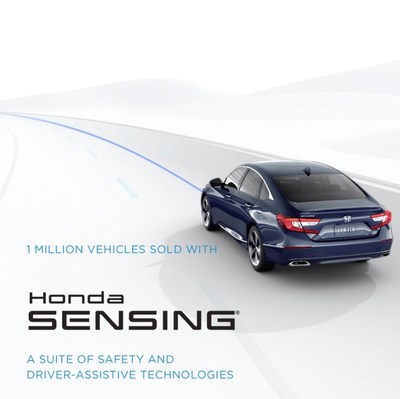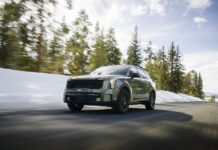TORRANCE, California, April 10, 2018 /PRNewswire-HISPANIC PR WIRE/ — Marking a major milestone in its history of safety leadership and innovation, Honda today announced U.S. sales of vehicles equipped with the Honda Sensing® suite of advanced safety and driver-assistive technologies has reached the one-million mark. Honda also will have standard Honda Sensing across the entire lineup by the 2022 model year. In addition, the Insurance Institute for Highway Safety (IIHS), an independent, nonprofit organization dedicated to reducing deaths, injuries and property damage from motor vehicle crashes, together with the Highway Loss Data Institute (HLDI), which publishes scientific studies of insurance data, issued a study on the effectiveness of Honda Sensing that determined its application resulted in significant reductions in collision claim severity, claim rates for damage to other vehicles or other property, and claim rates for injuries to people in other vehicles or others on the road.

“Honda dreams of a collision-free mobile society and the Honda Sensing technology has a crucial role to play in advancing us toward that goal,” said Henio Arcangeli, Jr., senior vice president of the American Honda Automobile Division & general manager of the Honda brand. “With the rapidly growing population of Honda vehicles applying these technologies, we hope to significantly reduce collisions involving Honda vehicles within the next three to four years.”
The IIHS study looked at more than 327,000 total insured vehicle years1 of 2016 model-year Accords, Civics and Pilots since this was the first model year Honda Sensing was available as an option on all trims.2 The 2016 model-year vehicles in the population without Honda Sensing served as the control vehicles in the study. When looking at the benefits of Honda Sensing, particularly the utility of the Forward Collision Warning and Collision Mitigation Braking System (with automatic emergency braking or AEB), the study concluded that even if a crash is not avoided, it is likely the striking vehicle at least slowed before the crash due to those systems, and noted the likelihood of injury is reduced when speed is reduced. The top findings of the study were:
- Collision claim severity is down $379 for the Honda Sensing equipped vehicles compared to those without the technology
- Damage to other vehicles or other property claim frequencies dropped nearly 11 percent for the Honda Sensing equipped vehicles compared to those without the technology
- Injuries to people in other vehicles or others on the road claim frequencies declined about 28 percent for the Honda Sensing equipped vehicles compared to those without the technology
“The data are clear. The role of Honda Sensing is reducing crash risk,” said Matt Moore, senior vice president of HLDI. “We commend Honda for rapidly expanding the application of this safety technology throughout its lineup.”
The Honda Sensing application rate has more than doubled from 2016 to 2017 to more than 50,000 vehicles per month in the past year, and now is applied on 69 percent of 2018 model-year vehicles. As a result, Honda plans to meet the voluntary commitment between the U.S. Department of Transportation, IIHS and 20 automakers to make AEB standard on at least 95 percent of all models two years earlier than the agreed upon year of 2022. Furthermore, Honda’s rapid deployment of these technologies and plans for application of Honda Sensing as standard equipment on all 2022 model-year vehicles goes beyond the voluntary commitment of just AEB. Honda’s plans, by contrast, encompass the full suite of Honda Sensing technologies, including:
- Collision Mitigation Braking System (CMBS™) – can apply brake pressure when an unavoidable collision is determined
- Forward Collision Warning (FCW) – can detect the presence of vehicles in front, activating audio and visual alerts to warn the driver if they are at risk of collision
- Lane Keeping Assist (LKAS) – can help bring the vehicle back to the center of a detected lane when unindicated lane drift is determined
- Road Departure Mitigation (RDM) – can adjust steering and braking if you cross detected lanes without signaling
- Adaptive Cruise Control (ACC) – can maintain a set following interval behind detected vehicles as well as maintain a set speed
Honda Sensing is standard equipment today on the 2018 Clarity Plug-in Hybrid, 2018 Clarity Fuel Cell, 2017 Clarity Electric, 2018 Accord, just-launched 2018 Accord Hybrid, and will be standard on the 2019 Insight hybrid sedan, slated for introduction later this year. The technology is available today on the 2018 Honda Fit, Civic Sedan, Coupe and Hatchback, CR-V and Pilot sport-utility vehicles, Odyssey minivan and Ridgeline pickup.
For More Information
Additional media information, including detailed pricing, features and high-resolution photography of all 2018 Honda models, is available at hondanews.com. To join the Honda community on Facebook, visit facebook.com/honda. Consumer information is available at automobiles.honda.com.
About Honda Safety
Honda has a long history of leadership in the development and application of advanced technologies designed to enhance the safety of all road users, including automobile occupants, motorcycle riders and pedestrians. The company operates two of the world’s most sophisticated crash test facilities, in Ohio and Japan, and is responsible for numerous pioneering efforts in the areas of crashworthiness, airbag technology, collision compatibility and pedestrian safety. Toward Honda’s goal of a zero-collision society, the company is broadly applying Honda Sensing® advanced safety and driver-assistive technologies, now on more than one million vehicles on U.S. roads today. These technologies can significantly reduce the likelihood or severity of a collision and also serve as a bridge to highly automated vehicles of the future. Honda is targeting 2020 for the deployment of vehicles with highly automated highway driving capability and 2025 for the technological achievement of SAE Level 4 automated vehicles for personal use.
About Honda
Honda offers a full line of reliable, fuel-efficient and fun-to-drive vehicles with advanced safety technologies sold through more than 1,000 independent U.S. Honda dealers. The Honda lineup includes the Fit, Civic, Accord and Clarity series passenger cars, along with the HR-V, CR-V and Pilot sport utility vehicles, the Ridgeline pickup and the Odyssey minivan.
1 Exposure is measured in insured vehicle years; an insured vehicle year is one vehicle insured for one year, two vehicles for six months, etc.
2 Honda 2016 model-year vehicles in the study include: Accord Coupe, Accord Sedan, Civic Sedan, Pilot 2WD and Pilot 4WD

Photo – https://mma.prnewswire.com/media/664658/Honda_Sensing_Now_on_More_Than_One_Million_Vehicles.jpg
Logo – https://mma.prnewswire.com/media/451598/Honda_Logo.jpg
SOURCE American Honda Motor Co., Inc.







